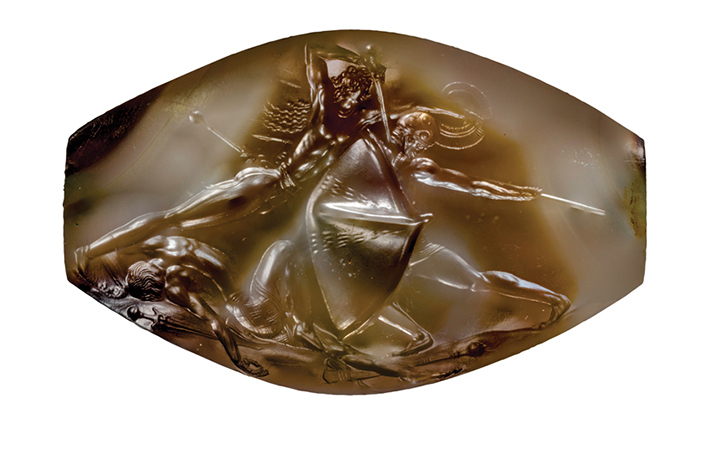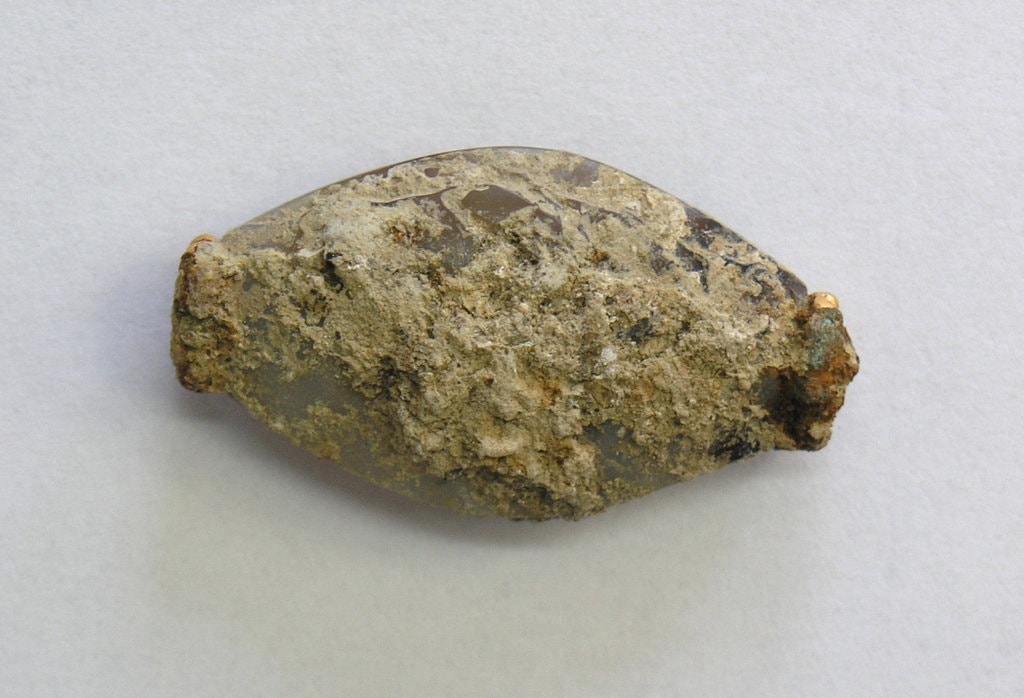Bitevní achát z Pylu (The Pylos Combat Achate)
 V květnu 2015 byla během výzkumu hrobu tzv. Gryfího válečníka poblíž Nestorova paláce v Pylu nalezena neobvykle krásná kamenná pečetidla. Šachtový hrob byl objeven archeology z University of Cincinnati, Jackem L. Davisem a Sharon R. Stockerovou, kteří v Pylu pracují už více než 25 let. Stockerová a Davis strávili posledních několik let budováním teorie, že Gryfí válečník a ti, kteří ho pohřbili, nebyli jen nadšenými sběrateli mínojského umění, ale smysl pro ně měl i symbolismus v něm obsažený. Tyto artefakty jsou dalším důkazem silného obchodního a kulturního spojení mezi lidmi v Pylu a na Krétě.
V květnu 2015 byla během výzkumu hrobu tzv. Gryfího válečníka poblíž Nestorova paláce v Pylu nalezena neobvykle krásná kamenná pečetidla. Šachtový hrob byl objeven archeology z University of Cincinnati, Jackem L. Davisem a Sharon R. Stockerovou, kteří v Pylu pracují už více než 25 let. Stockerová a Davis strávili posledních několik let budováním teorie, že Gryfí válečník a ti, kteří ho pohřbili, nebyli jen nadšenými sběrateli mínojského umění, ale smysl pro ně měl i symbolismus v něm obsažený. Tyto artefakty jsou dalším důkazem silného obchodního a kulturního spojení mezi lidmi v Pylu a na Krétě.
Pohřbený jedinec, známý podle zobrazení mýtického zvířete na jednom z předmětů v hrobě jako Gryfí válečník, zemřel kolem roku 1450 př. n. l. Žil v mimořádném období, kdy města na řecké pevnině absorbovala kulturní vliv mínojské civilizace z Kréty, ovšem předměty z jeho hrobu nás nutí opět upravit interpretaci vztahů mezi Mínojci a Mykéňany. V hrobě byly nalezeny tisíce artefaktů, mezi nimi několik pečetidel v mínojském stylu, vyrobených z ametystu, karneolu, achátu, ale i několik bronzových zbraní. Jedinec byl pohřben sám a hrob nebyl nikdy vykraden, takže je jisté, že všechny artefakty mají souvislost s ním a je možné studovat i jejich původní rozmístění.
Mezi pečetidly vyniká tzv. Bitevní achát, široký jen 3,5 cm. Na něm je vyrytá scéna souboje dvou válečníků s tak drobnými detaily, že krásu rytiny je možné plně obdivovat až na zvětšené překresbě. Pečetidlo ovšem stále obklopují dvě záhady. Jak a proč bylo vyrobeno s tak drobnými detaily? A lze tuto bitevní scénu nějak spojit s ústní tradicí, která se později ustálila ve formě Iliady a Odyssey?
 Archeologové věří, že pečetidlo i ostatní artefakty z hrobu Gryfího válečníka byly vyrobeny na Krétě – zatím nevíme, že by byla umělecká řemesla na řecké pevnině na takové výši. Detaily jsou tak drobné, že rytec i pozorovatel by potřeboval použít zvětšovací sklo.
Archeologové věří, že pečetidlo i ostatní artefakty z hrobu Gryfího válečníka byly vyrobeny na Krétě – zatím nevíme, že by byla umělecká řemesla na řecké pevnině na takové výši. Detaily jsou tak drobné, že rytec i pozorovatel by potřeboval použít zvětšovací sklo.
Vztah mezi ikonografií a artefakty přesvědčil Stockerovou a Davise, že Gryfí válečník byl znalcem minojského umění a že se jedná spíše o sbírku než o kořist. Dle Stockera je Gryfí válečník spojovacím článkem mezi Mínojci a Mykéňany, který ukazuje, jak blízce spojení byli.
The Pylos Combat Agate
On May 2015, after excavations at the so-called Griffin Warrior’s grave near Nestoras’s Palace in Pylos, southwestern Greece, archaeologists pulled out some extraordinarily fine seal stone artifacts. The shaft grave was discovered by Jack L. Davis and Sharon R. Stocker, archaeologists at the University of Cincinnati who had been digging at Pylos for more than 25 years.
The grave’s owner, known as the Griffin Warrior after the mythical animal depicted in his grave, was buried around 1450 B.C. He lived at a critical period when the Minoan civilization of Crete was being transferred to cities of the Greek mainland. But the grave and its contents are once again changing interpretations of the relationship between the Minoans and Mycenaeans. Among the thousands of artifacts from the Griffin Warrior’s grave are a few Minoan-style seal stones of amethyst, carnelian, agate and some bronze weapons. Much of this has been made possible by the fact that he was buried alone, and that his tomb was discovered undisturbed. This has allowed the team to both study the objects themselves and show how they were originally positioned.
Stocker and Davis have spent the last several years building a case that the Griffin Warrior, and the people who buried him, were not just avid collectors of Minoan art but were also highly clued into its symbolism. These artefacts are another proof that there was a strong trading and cultural connection between people living in Pylos and Crete.
As far as the category of seal stones are concerned, the most spectacular one is the Combat Agate, just 1.4 inches wide. The stone’s image, a sticking depiction of three warriors in battle, is carved in a remarkably fine detail and with some features that are barely visible to the naked eye. The image is easier to appreciate in a large-scale drawing of the original. But the seal stone presents two mysteries. One is how and why it was engraved in such detail. The other is whether its battle scene, strongly evocative of those in Homer’s “Iliad” and “Odyssey,” depicts an event that contributed to the oral tradition behind the works of Homer.
The researchers believe that the seal stone and other artifacts (bronze weapons, finely crafted gold jewelry and more) in the Griffin Warrior’s grave, were made on Crete. Work of such quality was not being produced anywhere on the Greek mainland at the time. The detail is so fine that it seems the engraver would have needed a magnifying glass, as would admirers of his work. The connections between the iconography and artifacts have convinced Stocker and Davis that the Griffin Warrior was an informed consumer of Minoan-style objects, not an indiscriminate looter. Somehow, Stocker says, the Griffin Warrior functions as a kind of bridge between the Minoans and Mycenaeans that provides evidence of just how closely interconnected they were.
Source:
Curry A., World of the Griffin Warrior, Archaeology (last visit:16/03/2020)
Wade N., A Grecian Artifact Evokes Tales From the ‘Iliad’ and ‘Odyssey’, New York Times (last visit: 16/03/2020)
Autor textu: Panagiota Diamatari
(překlad Josef Souček, Národní muzeum)







Komentáře
Přidat komentář